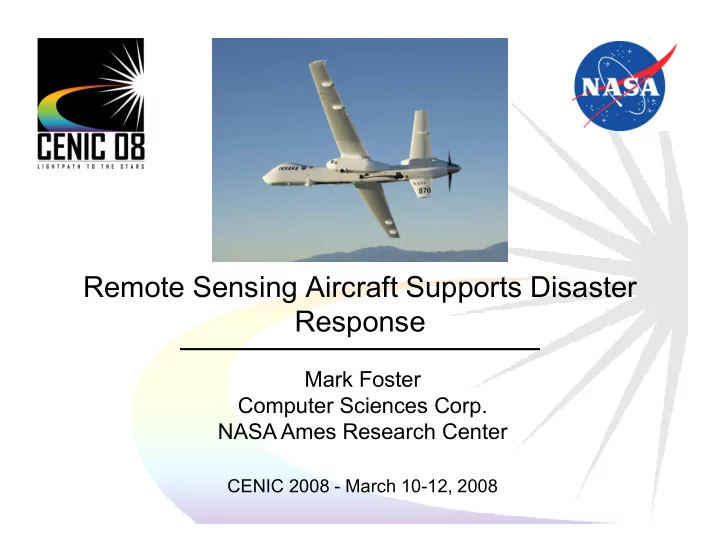

Remote Sensing Aircraft Supports Disaster Remote Sensing Aircraft Supports Disaster Response Mark Foster Computer Sciences Corp. NASA Ames Research Center CENIC 2008 ! March 10!12, 2008 1 ��������������������������������
Outline • Disaster Scenarios • Remote Sensing Aircraft: Ikhana • Data collection and redistribution • Field Retrieval of Data/Imagery • Field Retrieval of Data/Imagery • Successes, feedback • Affiliated efforts: Google NASA Disaster Response Project 2 ��������������������������������
Disaster Scenarios • fire – Zaca Fire ! Santa Barbara – Harris Fire ! San Diego – Lick Fire ! Bay Area • large scale flooding • regional earthquake • regional earthquake 3 ��������������������������������
Geospatial Data for Disaster Response • awareness is essential – identify problem areas and priorities – plan logistics, search and rescue – fix access routes and staging areas • multiple data types & sources ���������� – satellite and aerial imagery – satellite and aerial imagery – ground sensors (fixed & mobile) �������������������� – discrete and streaming data feeds • multiple users must be supported – government, commercial, non!profits – US&R, fire, police, community, etc. – range of experience, knowledge, needs ���������������������������� 4 ��������������������������������
Ikhana: Unmanned Science and Research Aircraft System • Predator B!derived to support Earth Science missions and advanced aeronautical technology development • testbed to improve utility of unmanned aerial systems unmanned aerial systems • designed for long!endurance, high!altitude flight; modified and instrumented for multiple civil research roles • 2400 lbs of instruments, can fly 18K!29K ft, or above 41K ft • Up to 24 hr data collection flight �������������������������� 5 ��������������������������������
Ikhana Autonomous Modular Scanner • 12 spectral channels, from visible through reflective, mid! and thermal infrared • detects thermal temperature differences from 0.5 to approx. 1,000 degrees F 1,000 degrees F • spatial resolution 50 ft at 20,000 ft altitude • PI: Vince Ambrosia, NASA Ames Research installing AMS in under!wing sensor pod Center (http://geo.arc.nasa.gov) 6 ��������������������������������
Ikhana Mission Planning Process Google Display: Publish Earth Google HTTP Server kml Generate Earth mission plan MODIS USFS, UMD ��� Weather Select Select NWS, NRL NWS, NRL Targets Google Earth text Fire Incidents Generate USGS, NIFC Flight plan Flight Restrictions FAA (Collaborative Decision Environment: courtesy Francis Enomoto,NASA ARC) 7 ��������������������������������
Data Collection/Distribution • sensor data preprocessed on!board • data downlink via geosynchronous satellite NASA Ames processing, • additional data ��� overlay overlay processing, merge with geo data Google Earth data at �������� Google NASA ARC prep for Earth redistribution • prepare for redistribution to Incident Command ����� �������� 8 ��������������������������������
CDE: Dynamic Data Display, Instant Messaging, Real!time Video 9 ��������������������������������
Collaborative Decision Environment: Google Earth client Real!time 3!D rendering and fly through of acquired fire imagery (CDE courtesy Francis Enomoto, NASA ARC) 10 ��������������������������������
Ikhana Support for Harris Fire • sophisticated thermal! infrared imaging equipment peers through smoke and haze • hot spots (in yellow) are concentrated on the ridgeline in the left ridgeline in the left center of the photo • images aid Incident Commanders in allocating resources 11 ��������������������������������
Data Retrieval in the Field • cell, wireless (HPWREN) when possible • NASA DARTCOM, NREN: portable satellite ground station – serve isolated command center center – higher data rate possible: • field deployable KU Band Satellite dish better fidelity images, • 2.8m improved interactivity • 10 shippable cases – supports data, voice, video • 1!30 Mbps bidirectional capabilities • NASA Ames permanent ground station provides a seamless and fully secured link – can provide ethernet, 802.11 to NASA Ames and internet resources for local access 12 ��������������������������������
Support for SoCA Firestorms • supported emergency request by CA! Governor’s OES, NIFC!NICC, FEMA • deployed team within 24!hours of request ��������������� • flew four missions ��������������� over ��� SoCA fires on Oct 24, 25, 26, 28 • delivered ��������� data to all fire Incident Commands (ICs) and county and city ���� Emergency Ops Center’s via CDE ������ • • > ������ ������ of data from ARC server > ������ ������ of data from ARC server �������� �������� ��� ��� • > !"�������������������� of CDE / day ������������� during six!day period of mission • provided burn area assessment imagery to support recovery efforts simultaneously with active fire imagery collection ����������� 13 ��������������������������������
Recommend
More recommend